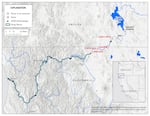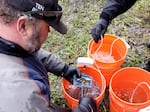“OK, babies! Here we go!”
Klamath tribal member and fish tech Charlie Wright coached dozens of young hatchery spring chinook as she poured them out of a bucket into a tributary of the upper Klamath River in Southern Oregon in November 2023.
“They’re like, ‘Oh, it’s cold!‘” she said as the fish swam away from the bucket and changed color in their new environment. “Look how pretty green they turn here. They look like happy babies.”
A lot of hope was pouring into the river along with those fish as the Oregon Department of Fish and Wildlife and the Klamath Tribes entered the beginning stages of starting a new run of spring chinook salmon. Those hatchery fish were the very beginning of what could be the first run of spring chinook to survive in the upper Klamath Basin since the early 1900s.
The country’s largest dam removal project took four dams off the Klamath River in Southern Oregon and Northern California over the past two years.
A free-flowing river has reemerged where Copco 1 and 2, Iron Gate and J.C. Boyle dams used to be. For Indigenous tribes, including the Klamath, Shasta, Karuk, Hoopa Valley and Yurok, the project was a huge victory.
Painful water conflicts have dragged on for decades in the Klamath Basin, with farmers, fish and tribes all suffering.
Now four dams are out, bringing renewed hope for salmon restoration. But on the Klamath, it’s going to take a lot more to piece the basin together again.
Above the former sites, the landscape has been transformed since the river last flowed free. Agriculture has come to dominate the region, bringing water pollution and impaired wetlands. And federal funding for many of the planned habitat restoration projects is frozen.

A map displaying the four dams along the Klamath River that have been removed, annotated in red. The Keno and Link River dams, annotated in black, are still in place. In the dams that have not yet been removed, tribes see challenges for returning fish, which may have been blocked last fall by the first of two dams still remaining in the upper Klamath Basin.
California Water Science Center / US Geological Survey
Two Klamath River dams have not been removed in Southern Oregon, so tribes see challenges for returning fish, which may have been blocked last fall by the first of two dams that still remain. That could bring a new dam removal fight – focused on the Keno and Link River dams.
With Link River Dam crucial to the Klamath Project irrigation system that delivers water to farms in the upper basin, more conflicts between tribes and farmers could be in store. But for now, many are focused on working together.
What are salmon coming home to?
A reconnected river promises better habitat for struggling salmon runs that used to be among the largest on the West Coast. Last fall, chinook salmon returned to stretches of the river in Southern Oregon they hadn’t seen in over a century.
But even tribal leaders who fought for dam removal are worried about what comes next for the fish returning to Oregon.

A fall chinook salmon swims through a tributary of the Klamath River in Oregon in October 2024, after four dams were removed downstream.
Paul Wilson
“Dams are coming out. Fish are coming home. But I think about: What are they coming home to?” Jeff Mitchell, chairman of the culture and heritage committee for the Klamath Tribes, said.
Above the former dam sites, the landscape was transformed for agriculture, with hundreds of thousands of acres of lakes and wetlands drained and converted to farmland.
Keno and Link River dams remain on this stretch of the river to divert water to farms, but there’s not enough water to go around.
So, the upper basin suffers from chronic drought and outbreaks of toxic bacteria in Upper Klamath Lake that are fueled by excess nutrients running off the surrounding farms and ranches.
Related: As the Klamath Basin faces another dry year, the effects are far-reaching
Last year, thousands of birds died from a bacterial disease called botulism, caused by a lack of water at the Klamath wildlife refuges.
Mitchell wonders how salmon will survive on this Southern Oregon landscape. It’s unclear whether they can even swim past Keno and Link River dams because their fish ladders weren’t built for adult salmon passage.
“We have a beautiful homeland,” Mitchell said. “But for 150 years, we’ve taken it the wrong direction. We’re on the edge of losing everything.”

FILE - The koptu, or shortnose sucker. C'waam and koptu are two species of resident suckerfish teetering on the brink of extinction. Two dams that weren’t removed in the Klamath Basin still stand in the path of returning salmon.
Courtesy of Klamath Tribes
Two resident fish populations depend on that lake. The lost river and shortnose suckers – known to the Klamath people as c’waam and koptu – face extinction as they continue to decline.
Just a few thousand of each remain, and most of their offspring die every year because of poor water quality and degraded habitat.
Related: C’waam and Koptu: The fish at the center of the Klamath Basin’s water crisis
“I’m hoping that we’ll be able to make a home again for salmon,” Mitchell said, “but right now we have a tremendous amount of work in front of us to do that.”
As the salmon swam back to Oregon for the first time in over a century, they returned to a landscape dominated by farms and ranches, where water shortages that started long before dam removal have created a world of hurt.
Homesteading on a lakebed
Scott Seus is a third-generation farmer in Tulelake, California. His grandfather was awarded a homestead here in 1946 as a World War II veteran. It was part of a federal program that drained Tule Lake and converted the land to farms.
“The settlers here are all veterans of World War I or World War II,” Seus said. “They were brought here by the government that was trying to get food security and trying to develop areas with irrigated agriculture. And so they were asked to do that and they moved their family down here. My dad was a month old when he moved here and set up roots.”
Many of the original homesteaders put their name into a giant pickle jar from which the government pulled the lucky winners of the newly created farmland.
“The lake bed that we’re living on is 6 million years of duck manure and tules,” Seus said.

The Klamath River flows freely through the former Copco 1 Dam site in Northern California in October 2024 after the country's largest dam removal project.
Brandon Swanson / OPB
“That’s what we call home now,” he said. “And it’s home to some of the richest and most fertile land in the country and raises phenomenal potatoes, onions, horseradish, garlic. That’s our bread and butter.”
For a while, it all seemed to work. Water flowed from Upper Klamath Lake to farms and wildlife refuges through a massive irrigation system.
But fish on both ends of that system were hurting. Suckerfish in Upper Klamath Lake were listed as endangered species in 1988. Coho salmon in the Klamath River were listed as threatened in 1997.
The law demanded more water for those fish, and farmers were stuck in the middle.
Conflicts over endangered fish
Conflicts over endangered species came to a head during a severe drought in 2001, when the federal government shut off irrigation water to farmers for the first time. Hundreds gathered to protest, and some tried to force the head gates open to release irrigation water.
“A lot of the homesteaders were still here, the original families,” Seus said. “They viewed that as, ‘We did what you asked us to do. We came and we settled. … We built communities. … And we provided the nation with food. And now the slap across the face.’ That was shocking for them. It’s been shocking for us.”
The next year, 2002, the government sent river water back to farmers for irrigation.
Downstream, Yurok tribal member Barry McCovey remembers painfully what happened next.
“The river was really low here in the lower Klamath. … And then we had a pretty big salmon fall salmon run predicted that year,” he said. “We lost upwards of 70,000 adult Chinook that fall. The banks of the river were littered with dead fish. All you would smell is rotting flesh of salmon.”
Following that fish kill, tribes up and down the Klamath River rallied for dam removal.
“Some tribal members … they kind of look at their lives as their life before that fish kill and then their life after that fish kill,” McCovey said. “It was that big of an event.”
Tribes and farmers spent years negotiating an agreement to remove dams and guarantee water for farms. But Congress never approved it.
The four dams ultimately came out because their owner, the utility PacifiCorp, had to find a way for salmon to swim past them – and removal was the cheaper option. The dams weren’t used for irrigation or flood control, and they made less than 2% of the utility’s electricity – which was easily replaced by existing power plants.
That was good for salmon, but it hasn’t changed the amount of water going to farmers.
“The path that we’ve been going down is less and less water for agriculture,” Seus said. “And our town is dying and our community is dying and our farms are dying and our kids are moving away from the farm and they’re not coming back because they don’t see a future here.”
Tribes and farmers find common ground
For years, farmers and tribes have gone to court to fight for the water both groups were promised.
But there have not been many wins for farmers, and fish populations have continued to decline.
So, some farmers are trying something different.
In April of last year, a group of farmers from the Klamath Drainage District drove down from the Upper Klamath Basin to meet fisheries workers with the Karuk Tribe in Northern California.
Their best hope now, they said, is for fish recovery – so endangered species protections can be lifted and water can flow more freely to farms.

FILE - Scotty Fenters drives his pickup truck.
Holly Dillemuth / JPR News
Last spring, fifth-generation Klamath Basin farmer Scotty Fenters learned he’d be getting less than half of the water he needs to grow a crop he had already planted.
“That’s not any way to run a business, and it’s extraordinarily frustrating,” he said. “That’s because of all the problems that are going on down here to protect fish like this. I understand it’s complicated but it doesn’t really work for anybody.”
So, Fenters idled about half of his farmland and joined a growing number of farmers who are adding wetlands to their properties for fish and wildlife.
“Oh, we’re spit balling any way we can,” he said. “If it helps to make things better, and in exchange we can get a little bit more guarantee for water. I mean, that’s the only way to move forward.”
Fenters said he wants to know what he can do sustainably.
“So I know what employees I can keep, I know what I can invest in crops, and I know what I’m leaving for my son,” he said.
“I view the salmon down river, especially for the tribes, as no different than my own crops,” Fenters said. “They’re trying to catch their fish as part of their heritage. … I want them to succeed as best as possible because their success is my success. If we can get the salmon to come back, maybe we can get a little bit of water security again, which would go a really long way.”

FILE - Karuk Tribe Fisheries Program Manager Toz Soto transfers threatened coho salmon from the Klamath River into buckets in early 2024. The fish were later released into nearby ponds in tributaries of the Klamath River to avoid harsh conditions during dam removal.
Juliet Grable / JPR
Toz Soto, fisheries director for the Karuk Tribe, said he could feel the tensions easing as farmers delighted in seeing the young salmon and steelhead swimming in the river after dam removal.
“I always key to people’s responses and when you pull in a net full of fish and they’re wriggling around in there and they’re all shiny,” he said. “You see people’s eyes light up … There’s been this decades-long fight over water. I, honestly, I think people are just sick of fighting.”
Until the dams came out, there was no chance of endangered salmon swimming around the farms in the upper Klamath Basin. But now, that’s a real possibility.
‘We have to fix it’
Last fall, salmon were seen at Keno Dam – the first major barrier above the four dams that have now been removed. But the fish still have not been seen above the dam. The state is now studying the feasibility of altering or removing Keno to help salmon swim past.
Chairman of the Klamath Tribes William E. Ray, Jr., said the tribes are agitating for swift action to ensure salmon passage around both Keno and Link River dams.
“We had a visit with the Bureau of Reclamation and the Fish and Wildlife Service and told them that these fish ladders are inadequate to get the fish around,” he said in a recent interview with OPB. “We’re not wanting to be patient anymore. We’re not wanting to wait.”
Alta Harris, director of the Klamath Tribes’ Ambodat department, said even after the country’s largest dam removal project, there are still more problems with dams on the Klamath River — and Keno Dam is a big one.
“We would like to see that dam removed to have a freer river for those fish coming back,” she said.

After Iron Gate Dam was removed, salmon were able to swim past the former site in Northern California for the first time in more than 60 years in October 2024.
Brandon Swanson / OPB
Other tribal members want to see both Keno and Link River dams removed. Link River Dam plays a crucial role delivering water to upper basin farms as part of Klamath Project irrigation system. So even after the country’s largest dam removal project, this basin might face yet another fight to take down more dams.
Last summer, Charlie Wright returned to the same creek where she released the hatchery spring chinook in 2023, before dam removal.
“The fish that we released, some of them did make it all the way to the ocean,” she said. “And that would be crazy, to see some of them come back in the next few years. I could just burst with joy for that.”
One day, her four young boys might be able to catch a salmon in that creek above Upper Klamath Lake.
But even with four dams removed, the path to this Klamath River tributary is a tricky one. Here, the water again stagnates. Lake water above the dams is often toxic.
If they could find their way, the creeks in the upper basin would offer great habitat for salmon – at the headwaters of the Klamath River that bubble up from underground springs.
“We have to fix it,” Wright said. “We all know the pieces fit together because we all watched it fall apart. So we know it can be successful and healthy again. But...we have to do the work.”
